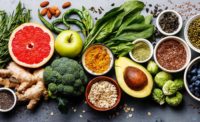Culinologists Meet Challenges of Bringing Plant-Based Product Development to the Next Level
Formulating plant-based products to maximize nutrition and deliver function is a growing opportunity, and selecting the right building blocks in formulation is critical

Increased consumption of plants and reduced reliance on animal products is a winning idea with consumers as plant-based meals deliver higher flavor profiles with cleaner ingredients.
PHOTO COURTESY OF: CuliNEX, LLC

Developing the final product to allow for fewer ingredients and a narrower preparation profile is today’s best recipe for final consumer appeal.
PHOTO COURTESY OF: Thrilling Foods, Inc.

New technology is creating growing options for developers to build plant-based analog formulations that appeal to a growing consumer base.
PHOTO COURTESY OF: Daiya Foods, Inc.

PHOTO COURTESY OF: MycoTechnology, Inc.

Naturally derived flavor boosters can help reduce sodium while adding much-needed umami notes to animal protein analogs.
PHOTO COURTESY OF: Ajinomoto USA, Inc.

New sources for plant-based ingredients include vegetables, roots, and fruits such as a pulled pork analog from jackfruit.
PHOTO COURTESY OF: Upton Naturals, Inc.






According to a recent Kroger/Plant Based Foods Association study, consumers tuned into plant-based eating are seeking more convenience, greater health benefits, and more attractive pricing in the category. The research suggests that to grow the category, new products and brands must appeal to an expanding market by providing these product features while creating the right messages to attract new buyers.
Formulating plant-based products to maximize nutrition and deliver function is a growing opportunity, and selecting the right building blocks in formulation is important. The gap between nutrition delivery and consumer desires is one that can be filled by a new generation and greater variety of products.
Food manufacturers are looking for ways to increase nutrition density and deliver consumer aspirations around food functionality with herbs, fruits and vegetables, and other additions. But achieving high enough concentrations of desired nutrients to provide an on-package message can sometimes present a challenge. One of the foremost of these is attaining sufficient levels of protein.
Protein 101
There are multiple issues and limitations in the processing and extraction of plant-based proteins. One major challenge is the difficulty in achieving high protein yields from plant-based sources to replace animal protein. Many plant-based protein sources have low protein content and require significant amounts of raw material to produce a small amount of protein.
The explosion of options‑from sources to technology‑demonstrates the commitment of ingredient makers and product developers to hit the mark on protein content in a new product. These new plant-based protein sources and processing techniques are improving the nutritional content, efficiency, and sustainability of product formulations. Extraction technology continues to improve through wet, enzymatic, ultrasound, membrane and more and preparation and design of the ingredient to refine and change the protein properties is evolving through extrusion and more.
In addition to advancements in biotechnology, genetic engineering also is being used to improve the efficiency and sustainability of plant-derived protein production. This does not necessarily mean lab-based genetic engineering. Agritechnology is finding ways to breed and cultivate seeds, grains, and legumes to naturally boost protein. Breeding of the cultivars is optimizing for solubility and functionality, and is evident in the formulation process on the bench.
Fermentation, too, is a technology that has shown promise for plant protein production. Not only is it a way to produce raw protein from plant cells, fermentation also is a way to modify and refine the characteristics of protein to make them to optimize and improve flavor and texture characteristics and make them otherwise more appealing.
Finally, the digestibility of plant proteins will continue to be important as we drive for more effective/efficient proteins for consumers. Bio-availability is a growing area of concern, and the development of cultivars and processing will impact the future for the winning sources and forms to be used for consumers products.
Build to taste…and texture
Work begins in plant-based product development by comparing, singly and in combination, specific plant proteins to their animal protein counterparts. Flavor, texture, and overall acceptability to consumers can vary greatly. Some people may find plant-based proteins to be just as tasty, if not more so, than animal-based proteins, while others may prefer the flavor and texture of animal-based proteins. But the interplay between these two factors, texture and flavor, is the key to success. Excellence in one can compensate for a slight lack in the other, but only a slight one.
The overriding goal in the development and testing of meat analogs is to mimic as closely as possible their animal counterparts in all applications, uses, and preparations. A specific meat analog might not be usable in all applications. For example, a formulation that delivers the perfect color of uncooked meat on the grocery shelf might not look like cooked meat when prepared in a pan. Or it will look different when it's prepared on a grill from when it’s roasted or when it’s air-fried.
Choosing to develop a product to be used in one application may be a better product design strategy than trying to make a single analog that will perform in multiple applications. Formulating finished products instead of single ingredients to replace animal proteins in consumers’ own meal preparation is a growing opportunity to broaden the category.
Plant meat 2.0
The meat analog development process carefully blends the ingredient building blocks to achieve texture, flavor, bite (elasticity and tension), color, and juiciness. In this process, finding an ingredient that resembles fat has proven to be a significant hurdle. A combination of plant proteins, starches, flours, binders, colors, and enhancers (flavor and texture) must be executed with great care and precision to replicate the organoleptic qualities of this one ingredient.
For example, when formulating a plant-based cured sausage, knowing if it will be sliced and served cold can completely change formulation. Gluten ingredients are a key to building great texture in a cold application, and a developer can manipulate the cold gel binders to optimize for texture, adding herbs, spices, and colors that deliver consumer appeal. If the cured sausage needs to be heated and served on pizza, a potato protein that is not thermal irreversible will yield the best result.
In addition, the color must be formulated to achieve appeal when the product is cooked instead of expecting the product to resemble uncooked meat color on the grocery shelf and transition to cooked meat appearance after heating. Selecting the finished application allows the developer to focus on fewer ingredients to achieve the right color when purchased and when prepared, optimizing for color stability.
A hot, fully cooked meal would be formulated for the final heating preparation, allowing a developer to use hydrocolloids best suited for heat application. The use of sauces, spice blends, and vegetables within a meal will increase the acceptance and help the product deliver on consumer expectations.
Table-ready
Today’s consumers are focusing on whole ingredients, less-processed foods, fewer modifiers, and a more recognizable ingredient statement. Clean-label concerns place demands on many finished product formulations when it comes to meat analogs.
Another challenge is the limited availability and high cost of some plant-based protein sources. Many plant-based protein sources, such as quinoa and lentils, can be expensive compared to the more common pea and soy proteins. This can make it difficult for the final product to be an affordable option for consumers.
In addition, many plant-based protein sources, such as legumes, require extensive processing and preparation to make them suitable for use in food products. This can add to the cost and complexity of producing plant-based proteins and reduce availability. The consumer desire for cost parity with animal products is driving manufacturers to shed costs from their products and pushing the ingredient industry to provide better value.
With creativity, exploration, and collaboration within the industry, the future is bright for food producers seeking to match plant-based consumer desires with a broad range of healthy, delicious new products designed to meet expectations. Smart product design is paramount.
Webb Girard, MS, Senior Director of R&D, leads the team at CuliNEX, LLC, a leading product development consultancy specializing in clean-label and plant-based formulation. Holding food science degrees from the University of Idaho and the University of Maryland, he is a veteran manager focused on projects requiring technical expertise in product/process improvement, process standardization, and plant scale-up. Reach him at webb@culinex.biz.
Plant Protein Mix & Match
Plant-based proteins are diverse when it comes to flavor, texture, and functionality in formulation. For that reason, most product makers lean toward blends. For example, Impossible Foods, Inc.’s Impossible Burger includes potato protein and textured wheat protein, while Beyond Meat, Inc.’s Beyond Beef products are GMO, soy, and gluten-free, made with a proprietary blend of pea, mung bean, and rice protein. Working with plant protein suppliers can help product developers craft the right proteins in the right combinations to attain products that perform to highly specific sets of organoleptic and functional parameters.
‘room to Grow
Marlow Foods, Ltd.’s Quorn brand pioneered fungi-based chicken and meat analogs beginning back in the 1960s. Its process of using fermentation creates a unique protein can make analogs with a more meat-like profile. And for decades, competition in the fungi-based analog field was nil. But with fermentation technology advancing at a rapid pace, other companies are stepping in. Meati, Inc., founded in 2016, also uses fermented mushroom mycelium—the fibrous root structure of fungi—to make its animal protein analogs. However, another use of mushroom fermentation is exemplified by new technology that stimulates shiitake mycelium to recreate pea and rice protein. Could the next step be animal proteins produced through the same process?
Plant-Based Momentum
Creating a range of options for consumers and clearly messaging those options to appeal to a variety of expectations can help grow the plant-based category. From increasing consumption of plant-forward foods for health and nutrition to improving products’ environmental sustainability, consumers bring a broad list of aspirations to the table. In creating a broader set of plant-based products, the food industry has an opportunity to fulfill consumer demand and increase sales.
Looking for a reprint of this article?
From high-res PDFs to custom plaques, order your copy today!











